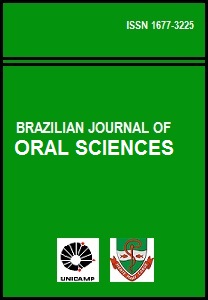Abstract
The purpose of this research was to compare the electromyographic (EMG) activity of the superior belly of orbicularis oris muscle between individuals with Class II Division 1 malocclusion, nose breathers (Group 1) and mouth breathers (Group 2), having as a comparative parameter a control group of individuals with clinically normal occlusion (Group 3). The EMG recordings were obtained in resting position and in 16 movements. A statistically significant difference between Groups 1 and 2 was observed during puffing out with flaccid cheeks, dispelling of the lips’ angle and saliva deglutition; between Groups 1 and 3 during puffing out with flaccid cheeks, posterior right and left clenching and saliva deglutition; between 2 and 3 during posterior right and left clenching. According to the normalized data the malocclusion groups (Groups 1 and 2) have a similar muscle behavior but when they are compared with the normal occlusion group there was a statistically significant difference between them. It can be concluded that, for this sample, the breathing mode did not influence the muscular behavior of the subjects with Class II division 1 malocclusion and that subjects with normal occlusion have more competent lips than the ones with Class II division 1 malocclusion.References
Subtelny JD. Oral respiration: facial maldevelopment and corrective dentofacial orthopedics. Angle Orthod. 1980; 50: 147-64.
Shaugnnessy TG. The relationship between upper airway obstruction and craniofacial growth. J Mich Dent Assoc. 1983; 65: 431-3.
Ung N, Koening J, Shapiro PA, Shapiro G, Trasnk G. A quantitative assessment of respiratory patterns and their effects on dentofacial development. Am J Orthod Dentofacial Orthop. 1990; 98: 523-32.
Gross AM, Kellum GD, Franz D, Michas K, Walker M, Foster M et al. A longitudinal evaluation of open mouth posture and maxillary arch width in children. Angle Orthod. 1994; 64: 419-24.
Behlfelt K, Linder-Aronson S, Mc Williamm J, Neander P, LaageHellman J. Dentition in children with enlarged tonsils compared to control children. Eur J Orthod. 1989; 11: 416-29.
Behlfelt K, Linder-Aronson S, McWilliam J, Neander P, LaageHellman J. Cranio-facial morphology in children with and without enlarged tonsils. Eur J Orthod. 1990; 12: 233-43.
Tourne LP. The long face syndrome and impairment of the nasopharyngeal airway. Angle Orthod. 1990; 60: 167-76.
Angle EH. Classification of malocclusion. Dent Cosmos. 1899; 41: 248-64.
Schlossberg L. An electromyographical investigation of the functioning perioral and suprahyoid musculature in normal occlusion and malocclusion patients. Northwest Univ Bull. 1956; 56: 4-7.
Tosello DO, Vitti M, Bérzin F. EMG activity of the orbicularis oris and mentalis muscles children with malocclusion, incompetent lips and atypical swallowing – Part I. J Oral Rehabil. 1998; 25: 838-46.
Tosello DO, Vitti M, Bérzin F. EMG activity of the orbicularis oris and mentalis muscles children with malocclusion, incompetent lips and atypical swallowing – Part II. J Oral Rehabil. 1999; 26: 644-9.
Ahlgren JGA, Ingervall BF, Thilander BL. Muscle activity in normal and postnormal occlusion. Am J Orthod. 1973; 64: 445-56.
Silva AMT, Marchiori SC, Ribeiro EC, Cechella C. Electromyography: evaluation of orbicularis oris muscles in rest and maximum contraction in mouth breathers children, before and after myotherapy. In: XIV Congress of the Internaional Society of Electrophysiology and Kinesiology; 2002. p. 385-6.
Schievano D, Rontani RMP, Bérzin F. Influence of myofunctional therapy on the perioral muscles. Clinical electromyographic evaluations. J Oral Rehabil. 1999; 26: 564-9.
Graber TM. The “three M’s”: muscles, malformation and malocclusion. Am J Orthod. 1963; 49: 418-50.
Jacobs RM. A clinical diagnosis of muscular pattern in orthodontic practice. Am J Orthod. 1969; 56: 70-80.
The Brazilian Journal of Oral Sciences uses the Creative Commons license (CC), thus preserving the integrity of the articles in an open access environment.

